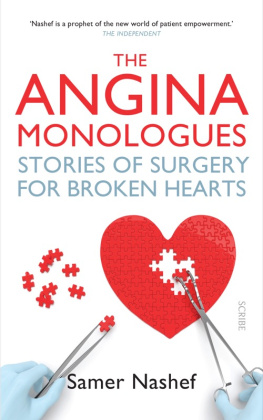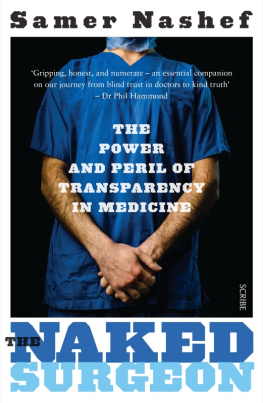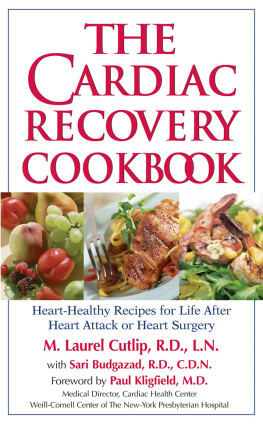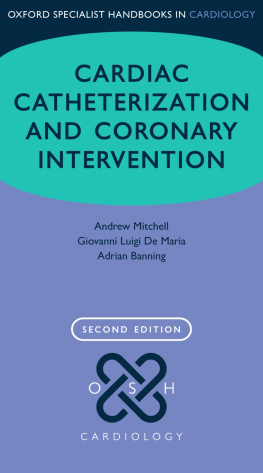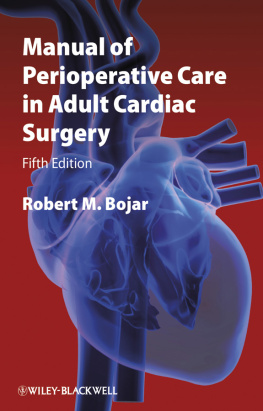
THE ANGINA MONOLOGUES
Samer Nashef qualified as a doctor at the University of Bristol in 1980 and is a consultant cardiac surgeon at Papworth Hospital in Cambridge. He is a dedicated teacher and communicator, and is recognised as a world-leading expert on risk and quality in surgical care. He is the author of The Naked Surgeon and a compiler of cryptic crosswords for The Guardian and the Financial Times .
Scribe Publications
2 John St, Clerkenwell, London, WC1N 2ES, United Kingdom
1820 Edward St, Brunswick, Victoria 3056, Australia
Published by Scribe in 2019
Copyright Samer Nashef 2019
All rights reserved. Without limiting the rights under copyright reserved above, no part of this publication may be reproduced, stored in or introduced into a retrieval system, or transmitted, in any form or by any means (electronic, mechanical, photocopying, recording or otherwise) without the prior written permission of the publishers of this book.
The advice provided in this book has been carefully checked by the author and the publisher. It should not, however, be regarded as a substitute for competent medical advice. Therefore, all information in this book is provided without any warranty or guarantee on the part of the publisher or the author. Neither the author nor the publisher or their representatives shall bear any liability whatsoever for personal injury, property damage, or financial losses.
For the protection of the persons involved, some names, biographical details, and locations have been changed.
The moral right of the author has been asserted.
9781911617785 (UK edition)
9781925713817 (Australian edition)
9781925693416 (e-book)
CiP records for this title are available from the British Library and the National Library of Australia.
scribepublications.co.uk
scribepublications.com.au
Contents
Appendix:
angina
Pronunciation: /andn/
NOUN
(also angina pectoris /p kt ()r s /)
A condition marked by severe pain in the chest, often also spreading to the shoulders, arms, and neck, owing to an inadequate blood supply to the heart:
he had high blood pressure and he suffered from angina
Latin pectoris of the chest
Oxford English Dictionary
To all the patients I have been privileged to treat
Foreword
Sometimes even dictionaries can get it wrong.
Angina is not a pain. It is more of a discomfort or pressure, a tightness or weight. And it is not usually severe, but is often accompanied by a feeling of impending doom, which makes you stop whatever it is you are doing in the way of physical exertion until it abates a few minutes later. It is also the Number One symptom that drives heart patients to seek medical help, with Number Two being shortness of breath.
This book relates the real-life stories of patients with angina and without who had major open heart operations to fix their cardiac problems. It tells of the triumphs and disasters of heart surgery, of the places where it is done and the professionals who do it, but always with a focus on the people who are at the centre of it all: the patients.
In writing this book I have selected stories that I hope provide a vivid illustration of different heart surgery patients, a wide range of heart conditions and the variety of procedures that a surgeon undertakes. Some of these stories are gory, some are funny and some have happy endings. Some of them have taken place at a time when I was able to put pen to paper (or fingers to keyboard) immediately, and, when that happened, I wrote down the events as they unfolded. Most of the other stories I have selected from memory and I have chosen them because they are memorable. Necessarily, some of these do not have a happy ending and that is precisely the sad reason why they are memorable. The aim of this book is, however, neither to scaremonger nor to sensationalise, but to provide an honest insight into my world. This is of course a world of drama, of life and death. It is also a world in which some of the finest attributes of human nature inventiveness and resilience shine most brightly both in the patients and in the people who care for them. Finally, it is a world which actually matters directly to you because, more likely than not, one day, either you or someone you love will need a heart operation. I hope that you will find this insight illuminating as well as interesting.
Few areas of human endeavour are laden with as much drama as heart surgery. With death always a presence and sometimes an immediate threat, the situations faced by patients and those who care for them can be emotional and nerve-wracking. People who deal with such stressful situations often evolve a number of coping mechanisms. Prominent amongst these is a dark and uncompromising sense of humour, one which probably exists in many surgical specialties, particularly those at the sharper end of the field. Some of these humorous and highly irreverent instances appear here, and I should like to apologise in advance if anyone finds such narrative offensive. I believe that I speak for all my colleagues when I say that such dark humour is, to us, merely a way of dealing with what sometimes can be unbearable stress. The fact that laughing in the face of adversity helps us through our working lives in no way diminishes how passionately we care about our patients and our work.
CHAPTER 1
Conflict of interest
Sometimes, in the words of Bob Geldof, I dont like Mondays, and yesterday was just such a Monday.
It was the first working day in January after the long Christmas break and, as such, it was something of a shock to the system. Instead of a gentle start, easing back in to work, I had two big operations on the first day. They were both complex, dangerous and challenging.
The first patient was a 47-year-old man. He needed two procedures done on his heart. Neither of the two was particularly challenging in itself, but the combination of them together in one operation was something I had never done before. The first procedure was a pericardiectomy and the second was a mitral valve repair. The first simply means removal of the pericardium or, in plain words, stripping the heart of its outside lining. This lining is normally a smooth and slippery bag, with plenty of room for the heart to move within it, and a little bit of fluid in which the heart can beat freely. This patients pericardium was no longer a smooth bag with a bit of fluid. The fluid had long gone as his pericardium had become thickened, scarred and rigid, firmly stuck to the heart within it and shrunken, strangling the heart, as in a straitjacket. This restricted the pumping action of the heart and caused heart failure. The second procedure was to repair his leaky mitral valve in the middle of the heart, which was making his heart failure even worse.
The trouble is that these two conditions do not usually come together and the two operations needed to fix them do not agree with each other. The first should ideally be done without using the heart-lung machine to reduce the risk of bleeding from the raw area after the lining is stripped off the surface of the heart and the second simply cannot be done without the heart-lung machine, thus greatly increasing the risk of bleeding from the first. To make matters worse, during the operation there was one bit at the back of the heart where the lining was so calcified and stuck that it proved impossible, despite many attempts, to separate it from the heart muscle without tearing the heart to shreds, so that the heart remained stuck at that point, making access to the mitral valve very difficult. Without being able to see the valve properly, I ended up repairing it mostly by feel. Thankfully, it worked, but this was more by luck than by judgement or skill.
Next page
